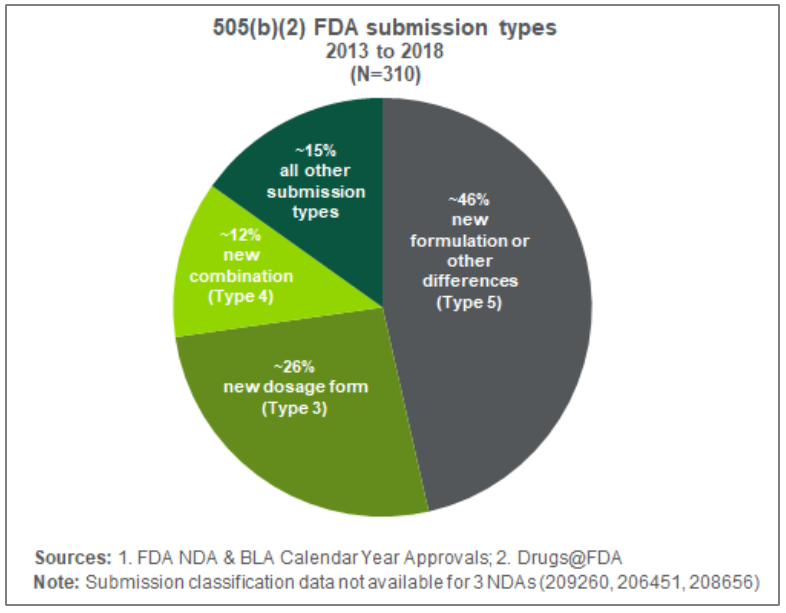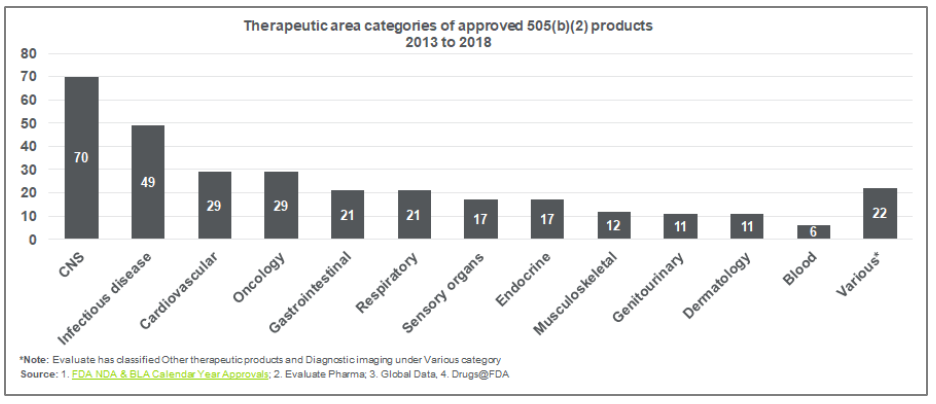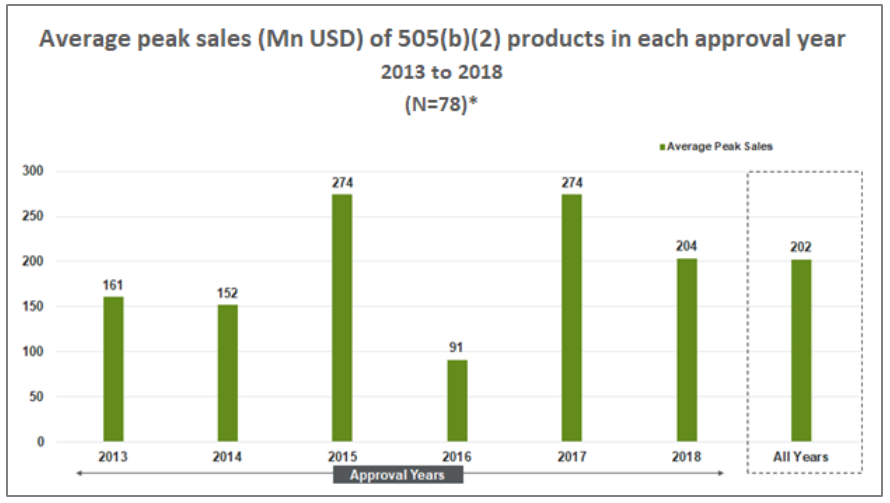505(b)(2): A Pathway to Competitiveness Through Innovation for Specialty and Generic Companies
As the market for specialty and generic products continues to become more competitive and pricing pressures increase, the 505(b)(2) pathway may allow companies more options to diversify their portfolios.
As the market for specialty and generic products continues to become more competitive and pricing pressures increase, the 505(b)(2) pathway may offer an attractive alternative for companies looking to differentiate their products and diversify their portfolios.
Section 505(b)(2) expressly permits FDA to rely on data not developed by the applicant to be considered for the registration of drug products. Generally, the sponsor is seeking a change to the product label claims (which must be supported with new data from appropriate studies) from the previously-approved product.
Approvals for 505(b)(2)s, which build upon and provide differentiation from previously approved products, has risen in recent years. In fact, FDA approved 313 such products from 2013 to 2018-comprising 50% of all NDA approvals. In this article, we analyze submissions, approvals, and sales trends during this time period to help companies more fully evaluate the 505(b)(2) pathway potential and identify areas of opportunity.
What is the current state of the industry?
The specialty and generic segments have recently fallen out of favor due to a range of pressures.
The generic industry is facing a steady decline in operational and financial performance. Median market capitalization for a group of large generic companies, for example, dropped from approximately $8 billion in September 2016 to $5 billion in September 2019, while enterprise value went from about $11 billion to $6 billion during the same time period. While these generic companies have thus far continued to maintain operating margins, they’ve experienced relatively flat top line growth-with an average revenue growth of just 1% per year from 2016 to 2019. Valuations of these companies were also materially impacted over the same time period, with revenue multiples reducing from 3.3x to 2.2x revenue and earnings before interest, tax, depreciation, and amortization (EBITDA) multiples reducing from 17.2x to 10.6x EBITDA.
Click to enlarge.

What makes the 505(b)(2) pathway unique?
The uniqueness of the 505(b)(2) pathway lies in its clinical trial requirements and approval timeline implications.
The traditional 505(b)(1) pathway for novel products requires the application sponsor to conduct all necessary studies to effectively demonstrate efficacy and safety. With the 505(b)(2) pathway, the sponsor must still demonstrate the same efficacy and safety standards as for a 505(b)(1) product, but they may do so by referencing existing data from trials they didn’t conduct and for which they don’t have right of reference. This offers the potential to build upon already approved products to bring new innovations-such as greater dosing convenience-to market significantly faster and at a reduced cost and overall risk. One of the main reasons development spend is low is because 505(b)(2) projects rarely fail because of unexpected side effects, which increases the probability of success relative to novel molecules.
What types of products are going through the 505(b)(2) pathway?
Ideal 505(b)(2) candidates offer a meaningful change from their reference product-such as a change in dosage form, strength, or formulation, a change in dosing regimen or route of administration, a new combination of drugs or drug and device, a new active ingredient, or a prodrug of an existing drug.
New formulations, dosage forms, and combinations make up majority of submissions
Click to enlarge.

FDA submissions are categorized by 14 different classification types. Of these, 505(b)(2) products with new formulations or other differences such as a new indication, application, or manufacturer (Type 5) were by far the most common-making up approximately 46% of all 505(b)(2) submissions with known classification data from 2013 to 2018. FDA received a total of 142 submissions for these products during the five-year time period, which was nearly double the next highest submission category.
Products with new dosage forms (Type 3) were also frequent, with 82 submissions over this time period. In third place, with fewer than half the submissions at a total of 38, were products with new combinations of two or more active ingredients (Type 4).
Less common classifications included drugs previously marketed without an approved NDA (Type 7) with 16 submissions, products with a new molecular entity (Type 1) with nine submissions, products with a new active ingredient (Type 2) with seven submissions, products with a new dosage form and new combination of ingredients (Type 3/4) at six submissions, and others.
Which therapeutic areas and indications have shown the most promise?
CNS led the way in 505(b)(2) approvals
From 2013 to 2018, central nervous system (CNS) products led the way with 70 approvals. Of these, those with a pain-related indication topped the list at 23 approvals. However, we forecast that pain product opportunities in the current environment will be challenging. Other top CNS indications included attention deficit disorder/hyperactivity (ADD/ADHD) and products to address opioid addiction, with seven approvals each.
Click to enlarge.

Infectious disease, cardiovascular, and oncology products also had a strong showing
Infectious disease gained 49 total 505(b)(2) approvals from 2013 to 2018, and HIV was second only to pain in submissions by indication, with 20 approvals. Many cardiovascular and oncology products also moved through the 505(b)(2) pathway, with 29 approvals each from 2013 to 2018. Gastrointestinal (GI) and respiratory followed, with 21 approvals each.
Within the cardiovascular space, 505(b)(2) products indicated for hypertension received 11 approvals, making hypertension the third highest indication for approvals during this time period. Products indicated for hypotension also came out high, with six approvals. In oncology, prostate cancer was the top indication, with eight approvals. Breast cancer, emesis, and non-small cell lung cancer each received six approvals. Rounding out the top indications were products indicated for the common cold (seven) and diabetes (six).
How do these products perform?
To provide insight into this question, we analyzed sales performance data for 78 of the 313 505(b)(2) products launched between 2013 and 2018. These were the products for which at least five years of sales performance data was available.
Five-year sales performance data shows attractive revenues
The data, which is a combination of historical and estimated sales, shows that products launched within this period had average sales that increased significantly year by year. Products achieved or are expected to achieve average sales of between $30 million and $100 million by year three. By year five, average sales grew or are projected to grow to between $50 million and $180 million.
In addition, average peak sales for these products over the same period ranged from ~$90 million to ~$270 million, with an overall average of ~$200 million, again highlighting the attractiveness of 505(b)(2) products.
Click to enlarge.

Strong sales and low development costs lead to significant ROI
The ability to rely in whole or in part on the core clinical data of the previously approved reference product can drastically lower risk and cost for 505(b)(2)s. Costs for development can range from as little as $3 million for those with no clinical trials to as high as $50 million when additional trials are required.
Combined with successful sales, this can result in impressive ROI. To calculate average ROI for the 78 505(b)(2) products we analyzed for sales data, we estimated an average R&D spend of $15 million per product. We then divided the aggregate five-year sales from launch by this estimated average R&D spend.
Over the five-year period of analysis, we estimate that products realized an ROI of between 10 and 36 times their R&D spend-with an overall average ROI of 26 times R&D spend.
What does a successful launch look like?
Recent successful 505(b)(2) launches include products offering greater dosing convenience, lower costs, and new formulations as compared to their existing referenced products.
For example, RAVICTI® (glycerol phenylbutyrate) was approved in 2013 for the chronic management of patients with urea cycle disorders (UCDs) who cannot be managed by dietary restriction and/or supplementation alone. Offering greater dosing convenience over the reference drug BUPHENYL® (sodium phenylbutyrate), RAVICTI garnered $824 million in sales from launch through 2018.
VASOSTRICT® (vasopressin injection) was approved in 2014 for increasing blood pressure in adults with vasodilatory shock (e.g., post-cardiotomy or sepsis) who remain hypotensive despite fluids and catecholamines. The first vasopressin injection in the market for the reference product PITRESSIN® (vasopressin), VASOSTRICT hit $1,293 million in total sales by the end of 2018.
BASAGLAR® (insulin glargine injection) was approved in 2014 as a new low cost, long-acting insulin formulation for the reference drug LANTUS® (insulin glargine), used to control high blood sugar in adults and children with type 1 diabetes and adults with type 2 diabetes. BASAGLAR achieved $950 million in sales from launch through 2018. We note, however, that under new regulations, insulin products will no longer be approved as 505(b)(2)s and will be instead guided under the biosimilar pathway. Thus, we excluded BASAGLAR from the above sales performance analysis.
BENDEKA® (bendamustine HCI), a particularly compelling launch success, was approved with orphan designation in December 2015 for the treatment of patients with chronic lymphocytic leukemia (CLL) or indolent B-cell non-Hodgkin lymphoma (NHL) that has progressed during or within six months of treatment with rituximab or a rituximab-containing regimen. BENDEKA offered a modified dosage form that provided greater dosing convenience than its reference product TREANDA® (bendamustine HCI). BENDEKA was an immediate success and went on to achieve $1,959 million in sales from 2016 to 2018.
How can companies successfully harness the potential of the 505(b)(2) pathway?
Our analysis shows there is great potential in the 505(b)(2) pathway. The key is being selective and strategic about which products to develop, and then creating a careful plan for submission and launch.
When evaluating potential for 505(b)(2) products, companies must consider these three key factors that lead to success:
- Strong quality clinical data for the referenced product, and careful strategic planning for FDA requirements and potential clinical trials: With the right planning, the limited need for trials for a 505(b)(2) product can shorten time to market, providing companies with the ability to better predict and control marketing opportunities and gain market share with less competition. Our analysis shows that from 2014 to 2018, the average time from filing to approval for 505(b)(2) products ranged from just 6 months for those under priority review to 10 months for those under standard review. From 2013 to 2018, 43 of the 313 products submitted to the 505(b)(2) pathway received priority review status.
- A clear and meaningful differentiation from the referenced product that offers potential for market exclusivity: 505(b)(2) products offer market exclusivity that can range from 3 years for a new formulation or indication to up to seven years for an orphan drug designation. However, some 505(b)(2) products that rely solely on bioavailability studies do not receive exclusivity. So, having a differentiated product that meets an unmet need and gaining an early understanding of market exclusivity potential from the pre-IND meeting with FDA is crucial for determining ROI potential.
- A robust marketing plan for communicating differentiation: While 505(b)(2) products typically require significantly less sales and detailing efforts than a new chemical entity, a strategic marketing effort is essential to a successful launch.
With the right planning and strategy, 505(b)(2) products offer a powerful combination of factors that increase the potential for strong sales and significant return on investment (ROI).
Eduardo Schur is a managing director; Doug Balogh is a director; and Mohit Jain is a consultant in the Life Sciences practice at Navigant, a Guidehouse Company. Vinay Torani formerly served as a managing director in the Life Sciences practice at Navigant.
Navigating Distrust: Pharma in the Age of Social Media
February 18th 2025Ian Baer, Founder and CEO of Sooth, discusses how the growing distrust in social media will impact industry marketing strategies and the relationships between pharmaceutical companies and the patients they aim to serve. He also explains dark social, how to combat misinformation, closing the trust gap, and more.
FDA Grants Priority Review to Regeneron’s Eylea for Macular Edema Following Retinal Vein Occlusion
April 18th 2025Regulatory action was based on data from the Phase III QUASAR trial, which demonstrated that Eylea HD dosed every eight weeks achieved non-inferior visual acuity outcomes compared to Eylea in patients with macular edema following retinal vein occlusion.